RV Cell Phone Boosters: Better Cell Signal for RVs
While there are so many benefits to RV’ing, reliable cellular signal is often not one of them. Most RV’ers find themselves at the edge of the network, leading to dropped calls, undelivered texts, and excruciatingly slow data. RV living, working on the road, and keeping the kids entertained becomes difficult without a reliable cellular connection. RV cell phone signal boosters can help keep all passengers connected in almost any situation for work and play.
Take advantage of our system design and installation services. Learn more or call us for a free consultation: 1-800-969-8189.
First, What Causes Weak Cell Signal in RVs?
Whether you’re yamping, at an RV campground, or on the go, poor cell signal is the result of:
- Being too far from your carrier's cell tower.
- Obstacles like trees, hills, mountains, buildings, and the RV’s frame degrade cellular signals, preventing devices from receiving adequate reception.
Cellular boosters overcome both challenges.
How Do RV Cell Phone Boosters Work?
RV signal boosters take your outside 5G/4G/LTE cell signals and deliver them even stronger inside. They use:
- An Outside Cellular Antenna – Captures your existing outside signal. Depending on cellular booster configuration, it’s typically installed on the roof, side mirror, or railing. RV outside antennas can be either omnidirectional or directional.
- An Amplifier – Amplifies the cellular signals received from the outside antenna. Amplification power varies across signal boosters.
- An Inside Antenna – Broadcasts the boosted signal inside the RV. Depending on included RV inside cellular antenna, it can be installed on the dash, a flat surface, or a wall.
A sliver of signal must be available at your campsite or on your route for an RV cell phone booster to work. They are not magic bullets. They will not improve your cellular connection in dead zones.
Things to Consider When Choosing an RV Cell Phone Booster
There are various cellular signal boosters for RVs available from different manufacturers. It can be difficult selecting the best one for your needs. Here are the top 4 things to consider:
1. Stationary vs. Mobile
Stationary RV boosters can ONLY be used while stationary. These units are typically equipped with an outdoor Yagi antenna, making them more powerful than a mobile unit. The antenna must point in the direction of your closest cell tower. Any time you change locations, you will need to re-orient the antenna.
Mobile RV boosters can be used while driving and stationary. You can enjoy reliable talk, text, and data while relaxing at your destination or on your way to your destination. They include omnidirectional antennas. Since they can capture cell signals from all directions, they work while in motion. Though, they are not as powerful as stationary RV cell boosters, nor do they work as well in remote areas.
2. Amplification Power
All cellular boosters have a maximum amount of amplification due to FCC regulations. This helps prevent cell boosters from being too powerful and potentially damaging the network. Amplification power is measured in gain, which for RV boosters can range from +50 dB to +65 dB. The higher the gain, the better your cellular signal strength in poor coverage areas.
Other measurements to look out for are uplink and downlink output powers. Uplink represents the link to the cell tower. A higher uplink output means the unit has farther reach to cell towers. Downlink represents max signal the unit can broadcast inside the RV. The higher it is, the better coverage you can expect.
3. Carrier Support
Some cellular boosters support multiple carriers simultaneously while others only work with one carrier at a time. Single-carrier RV cell phone boosters are the more powerful option. However, if you often travel with friends and family who all subscribe to different carriers, a multi-carrier RV cell phone booster would be better for your RV.
4. Power Supply
An RV cellular booster can be powered three ways:
- DC/DC Power Supply – Connects to the RVs cigarette lighter. Allows booster to work while in motion.
- AC/DC Power Supply – Connects to a wall outlet. Will power RV booster while stationary when electricity is available.
- Hardwire Power Supply – Connects RV booster directly to RV battery. Will keep booster on while stationary or in motion.
Best RV Cell Phone Boosters
weBoost Destination RV
Best for:
- Class A Motorhomes
- Class C Motorhomes
- Fifth Wheels
- Toy Haulers
- Travel Trailers
The weBoost Destination RV is the most powerful multi-carrier cell phone booster for stationary motorhomes and towables. It features up to +65 dB gain, with up to +21 dBm uplink and +12 dBm downlink. Its high gain and output powers allow for superior cellular signal boost anywhere for multiple devices. Since it’s equipped with an outdoor Yagi and indoor panel, it works wonders in weak signal campgrounds. No more dropped calls or sluggish internet while traveling or working. Adequate antenna separation is needed for optimal performance, making the Destination RV best for large RVs.
Kit includes:
 |
Yagi RV antenna. Can only send and receive cellular signals from one direction. Thus, it must point at your closest cell tower. Offers greater reach to cell towers than an omnidirectional antenna. Antenna mounts on 25 ft telescoping pole. |
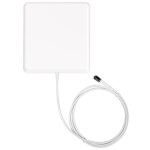 |
Panel antenna. Is also directional. Typically, wall mounted. It is able to push out a stronger signal than other RV indoor antennas, providing greater coverage. |
 |
Easily attaches to the side of your motorhome or towable. Helps get antenna as high as possible to mitigate outdoor interferences and maximize line of sight with the closest cell tower. Will need to be taken down when changing locations. |
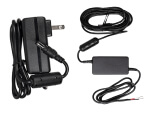 |
AC/DC and hardwire power supplies included. AC/DC connects to a standard wall outlet and powers weBoost Destination RV when electricity is available. Hardwire power supply draws power directly from RVs battery. If electricity isn’t available, you can stay connected at any campsite. |
Cel-Fi GO M RV
Best for:
- Class A Motorhomes
- Class B Motorhomes
- Class C Motorhomes
- Truck Camper
The Cel-Fi GO M RV is a powerful, single-carrier mobile RV cell phone booster. Because it only works with one carrier at a time, it features the highest gain of any mobile cellular booster, up to +65 dB. Through the Cel-Fi WAVE app, you can modify which carrier you want to boost at any given time. You can also switch the GO M RV from mobile mode to stationary mode. When stationary, it offers up to +100 dB gain. While driving on remote roads or camping on the edge of the network, the GO M RV provides superior reception. The components of the kits make the GO M RV best for motorhomes. Though, with a few modifications, it can also fit towable RVs.
Kit includes:
 |
OTR antenna. It’s heavy-duty and high performing. Omnidirectional, it captures your carrier’s incoming cell signals from every direction. Included mounting hardware allows for easy antenna installation on side mirror or pole. |
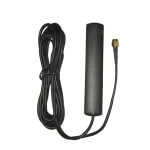 |
Patch antenna. It’s designed to be installed on the dashboard, predominately covering the cockpit. It’s not powerful enough to cover an entire RV. It can be upgraded to a more powerful desktop indoor antenna and placed mid-cabin for wider coverage. |
 |
AC/DC and DC/DC power supplies included. AC/DC wall power supply powers Cel-Fi GO M RV when electricity is available. Best for stationary use. DC/DC power supply powers Cel-Fi GO M RV via cigarette lighter port. Best for mobile use. |
weBoost Drive Reach RV
Best for:
- Class A Motorhomes
- Class B Motorhomes
- Class C Motorhomes
- Towable RVs
The weBoost Drive Reach RV is weBoost’s most powerful multi-carrier mobile RV booster. It offers up to +50 dB gain, as well as increased output powers of up to +28.7 dBm uplink and +5.1 dBm downlink. When compared to others in its class, the Drive Reach RV could reach cell towers located twice as far and deliver twice the signal strength due to its powerful amplification abilities. It’s definitely a no-brainer for those who want better coverage while driving through the most rural of roads or parked in the most rural of campsites.
Kit includes:
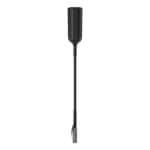 |
weBoost's optimized OTR antenna. Is one of the most powerful RV antennas on the market. Can be configured into multiple lengths from 7.5 - 20.5 inches. Included mounting hardware allows for easy antenna installation on ladder or pole. |
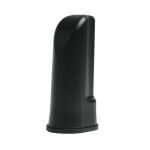 |
Desktop antenna for RVs. Can be placed on any flat surface about 13 ft from the amplifier where strongest signal is desired. |
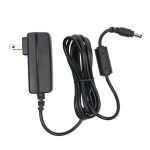 |
AC/DC wall power supply included. Will only power booster when electricity is available. To use while in motion we recommend a hardwire power supply (sold separately). |
SureCall Fusion2Go 3.0 RV
Best for:
- Class B Motorhomes
- Class C Motorhomes
- Travel Trailers
The SureCall Fusion2Go 3.0 RV is an award-winning cellular booster for RVs. It offers up to +50 dB with self-optimizing technology for the constant uptime of dependable signal. With up to 29 dBm uplink, it features greater reach to cell towers than any other RV cell booster on this list. Unlike other RV cellular boosters, this unit includes an inside omni whip antenna. It takes up less space and is easier to install.
Kit includes:
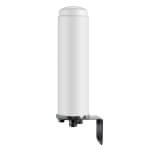 |
Omni antenna. Not your typical RV antenna. This type of outdoor antenna is typically paired with a home cellular booster. SureCall has optimized it for RV use. It outperforms some of the competition. Mounting hardware is designed to attach to a mast (not included). |
 |
Whip antenna. Connects directly to amplifier. Makes installation easier and minimizes the use of coaxial cable. Location of antenna and amplifier should be where signal is needed most. |
 |
AC/DC and DC/DC power supplies included. AC/DC wall power supply powers SureCall Fusion2Go 3.0 RV when electricity is available. Best for stationary use. DC/DC power supply powers Fusion2Go 3.0 RV via cigarette lighter port. It has a switch to turn it off. Best for mobile use. |
weBoost Drive X RV
Best for:
- Class B Motorhomes
- Class C Motorhomes
- Towable RVs
The weBoost Drive X RV is an exceptional performer in urban, suburban, and some rural roads and campgrounds. It showcases up to +50 dB gain with an average of +23.7 dBm uplink and +2.43 dBm downlink. This allows the unit to communicate with relatively faraway towers to deliver the strongest cell signal possible for better talk, text, and data. While not as powerful as the Drive Reach, the Drive X is better for small to medium-sized RVs.
Kit includes:
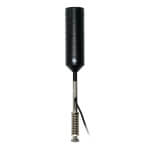 |
weBoost's OTR antenna. Omni directional, it captures cell signals from all directions from all cellular providers. Can be configured into multiple lengths from 7.5 - 20.5 inches. Included mounting hardware allows for easy antenna installation on ladder or pole. |
 |
Desktop antenna. Can be placed on any flat surface about 13 ft from the amplifier where strongest signal is desired. |
 |
AC/DC and hardwire power supplies included. AC/DC wall power supply powers weBoost Drive X when electricity is available. Best for stationary use. Hardwire power supply can power weBoost Drive X while driving or stationary. Will continuously draw power from the RV battery. |
HiBoost Travel 4G 2.0 RV
Best for:
- Class B Motorhomes
- Class C Motorhomes
- Travel Trailers
The HiBoost Travel 4G 2.0 RV is a relatively inexpensive yet powerful recreational vehicle repeater. With gains up to +50 dB and powerful output powers (up to +22 uplink and +6 downlink), it will definitely enhance 5G/4G/LTE signals on rural, suburban, and urban roads or campsites. Featuring the Signal Supervisor App, you’re able to monitor performance, optimize your antennas, troubleshoot, and more from the palm of your hand.
Kit includes:
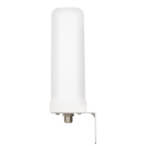 |
Omni antenna. Not your typical RV antenna. This type of outdoor antenna is typically paired with a home cellular booster. HiBoost has optimized it for RV use. Mounting hardware is designed to attach to a mast (not included). |
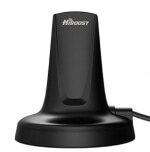 |
Desktop antenna. Can be placed on any flat surface a few feet from the amplifier where strongest signal is desired. |
 |
AC/DC and DC/DC power supplies included. Travel 4G 2.0 can be set up to work while stationary or in motion. |
How to Get the Most Out of an RV Cell Phone Booster
To get the best possible signal amplification and coverage the optimal signal booster RV antenna setup is key.
RV Antenna Placement
It goes without saying that outdoor RV antennas, sometimes called donor antennas, go outside and indoor RV antennas go inside.
There is not much to finding the best spot for outdoor RV antennas. They are typically placed on the roof towards the back of the roof of motorhomes or towables. When it comes to the indoor antenna, placement is everything.
In a perfect world, cellular boosters for RVs would be able to provide bumper-to-bumper coverage. However, that is not the case. It all depends on the strength of the signal at the donor antenna. Thus, the indoor RV antenna should be placed in the area where the most mobile activity occurs. Reception will be strongest the closest you are to the indoor antenna.
If continuous reliable reception is needed in the cockpit, place the antenna there. Patch or low-profile inside antennas for RVs are best for this. On the other hand, if continuous reliable reception is needed mid-cab, it’s best to place the inside antenna there. Desktop antennas and whip antennas for RVs are best for this setup.
RV Antenna Aiming
There are two types of outdoor cellular antennas for RVs: Omnis and Yagis. Omni antennas do not require any aiming, you just set them and forget them. Because Yagis are directional, they must point at your closest cell tower for best results. Our cell tower locator guide can help you find cell phone towers near you.
Most indoor RV antennas are omnidirectional. They will broadcast boosted cell signals in every direction, no aiming is required. Others, like the patch antenna, are directional. They must face the direction you want cell signal to be distributed to.
RV Antenna Separation
When cellular antennas are too close to each other, oscillation (feedback loop) occurs. While each manufacturer has an ideal separation requirement, it’s okay if you can't meet it. The antennas are often unlikely to interfere with each other in areas with weak cellular signals. If there is ever an oscillation problem, the booster will let you know.
RV Antenna Height
Obstacles often block incoming cellular signals. The higher you can get the outside antenna, the better line of sight it can have with nearby cell towers.
Do RV Cell Phone Boosters Work with Hotpots?
Hotspots use the cellular network to provide a dependable WiFi connection. RV cell phone boosters improve the cellular connection hotspots receive, allowing for greater hotspot performance.
Need Help Choosing an RV Cell Phone Booster?
Singal Boosters can help! We are a leading provider of home, commercial, and mobile signal boosters. Call us at 1-800-470-6777 and speak to one of our signal experts for assistance.
Interested in Learning More? Check Out Our Cellular Info Hub / WiFi Info Hub











